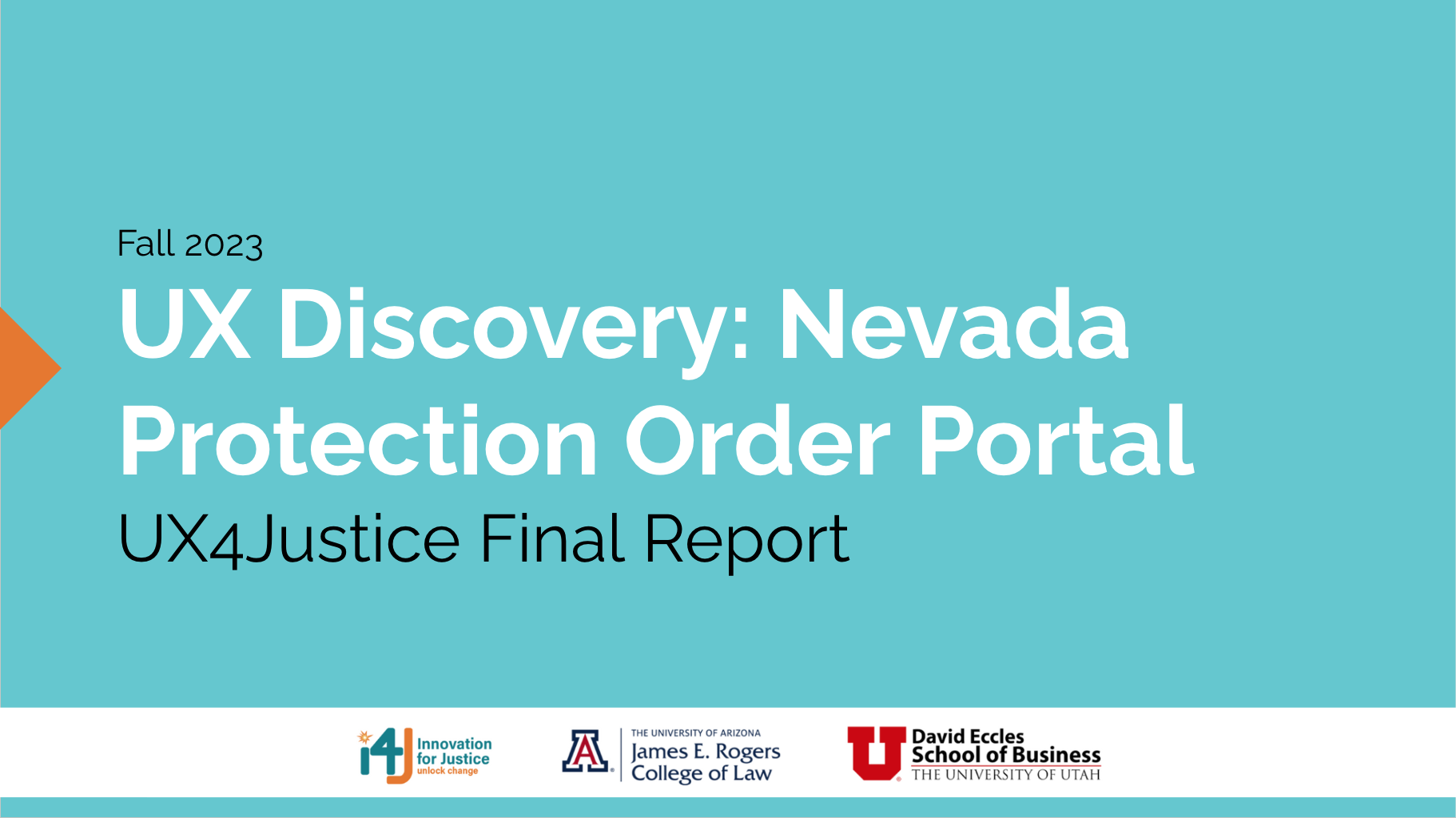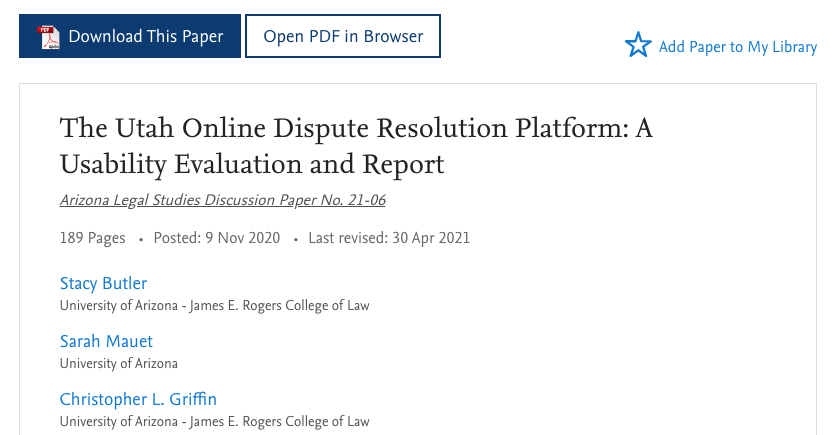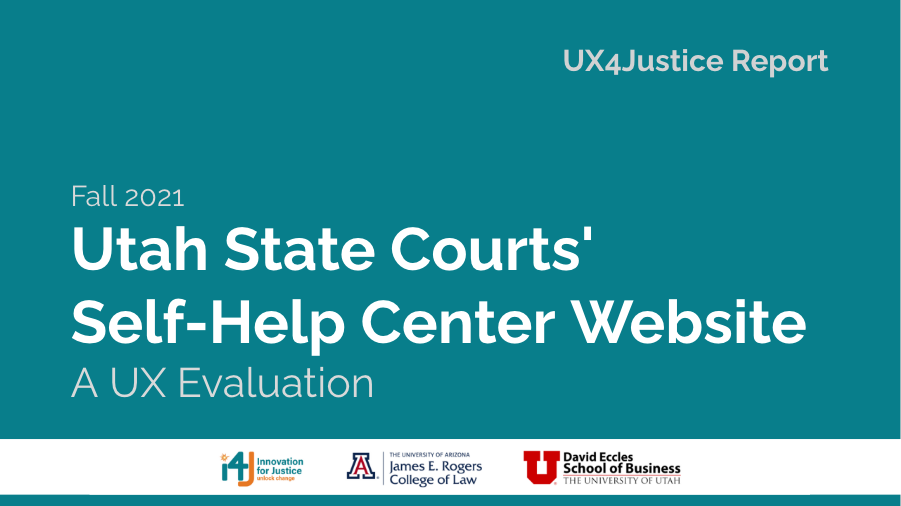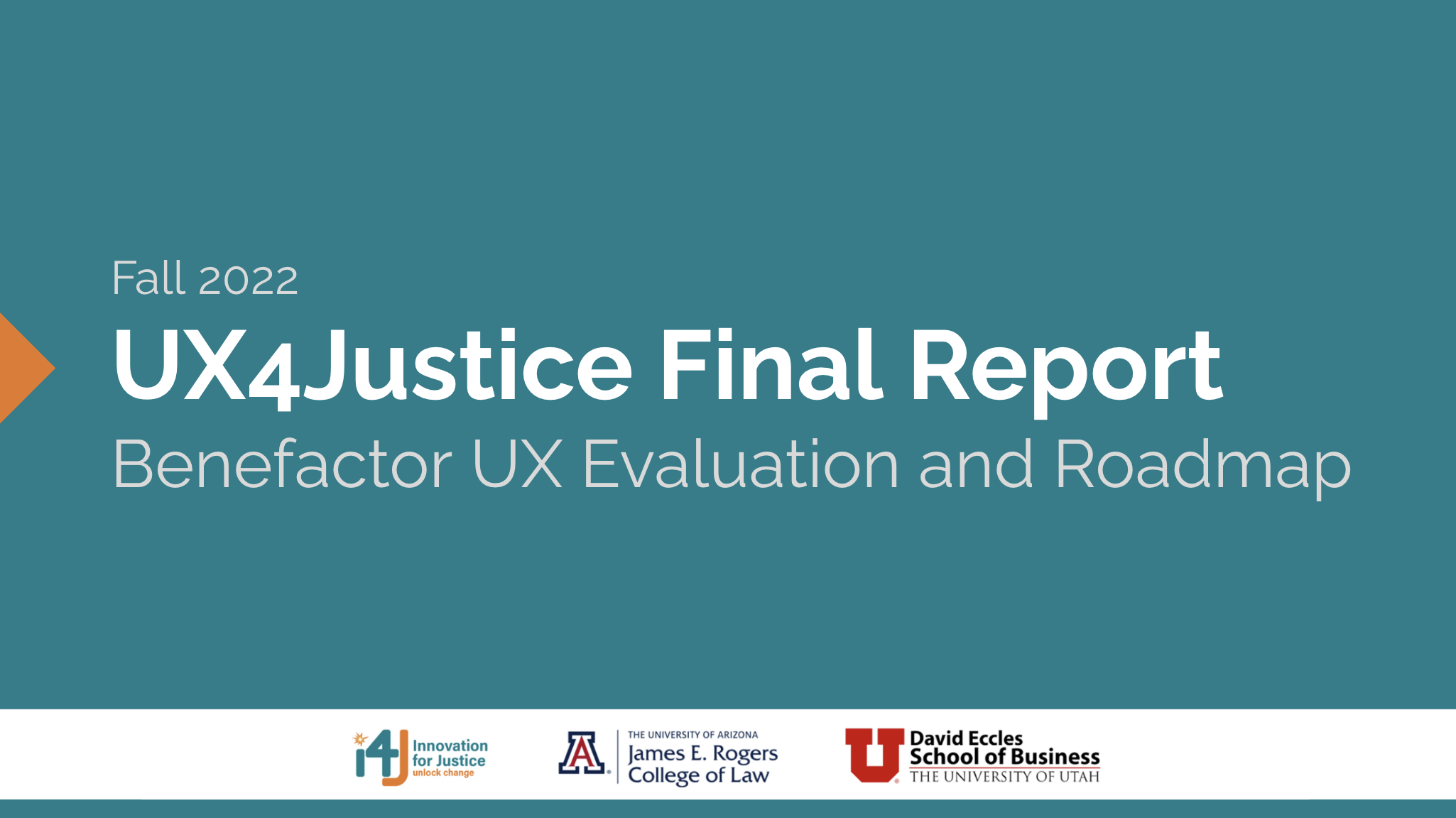System Impact Area
Advancing access to justice through human-centered technology design.
i4J’s work in the System Impact Area is unique because it is at the forefront of utilizing user experience (UX) research and design methodologies to evaluate and redesign online court technologies and processes, and is the only program of its kind embedded in a university learning experience.
With digital transformation rapidly changing the justice sector, legal systems across the nation are grappling with ways to operate remotely and online: online dispute resolution, e-filing, triage tools, and digital self-help resources—including chatbots and generative AI—are just a few examples.
In the rush to provide technology-based services, a user-centered approach is often not prioritized. And that’s unfortunate, because the people who most need those services are often the ones who find them the hardest to access and use.
The challenge—and opportunity—now is to integrate UX research and design into this digital expansion so the technologies launched are useful, intuitive, and serve the needs of all users.
i4J’s System Impact Area evaluates and redesigns existing and emerging public-facing justice sector technologies to ensure that they serve the needs of all court users as they navigate the civil legal system. We bring a diverse set of system actors together to co-create technologies that are easier to access and use for everyone because they are informed by multiple perspectives and real needs. By engaging would-be court users in the design of court technologies and processes, i4J’s System Impact Area is leading the way in educating and empowering the legal sector to create tech solutions that improve the administration of justice and better meet the needs of the people they serve.
“The public wants courts to use technology to make court processes not only more efficient, but more understandable, fair, and accessible.”
— Joint Technology Committee, National Center for State Courts
Why UX for justice technologies matters
The System Impact Area was launched at a critical moment in history. Prior to the COVID-19 pandemic, the civil legal system was primarily designed to facilitate in-person appearances, which limit access for those with inflexible work schedules, transportation limitations, medical issues, caregiving demands, or disabilities. As a result, many would-be users of the civil legal system simply did not—or could not—engage with it.
Technology offers a promising, albeit partial, solution to the justice crisis by replacing in-person appearances with remote and online court processes. Successful use of technology has the potential to relieve barriers attributed to in-person appearances and deliver faster resolution, enhanced engagement with the legal process, fairer outcomes, improved court efficiency, and increased knowledge and exercise of legal rights. In a 2017 National Center for State Courts survey, more than 80% of respondents wanted more online access to local courts, including the ability to ask for guidance from court staff online rather than visit the courthouse.
Optimism that technology can reduce the justice crisis, however, overlooks the reality that many people must overcome educational, language, technical, and access hurdles before using digital tools - this is known as the digital divide. The American College of Trial Lawyers (ACTL) has recognized the justice system’s rush to a remote and online models has exacerbated challenges for underserved and underrepresented litigants who may be technologically challenged, lack access to technology or the internet, or may have other barriers that affect accessibility. There are substantial disparities in access to smartphones, home broadband internet, and home computers in America depending on income and race (Digital divide persists even as Americans with lower incomes make gains in tech adoption), and people who live in rural communities are less likely to own technology than their urban counterparts and less likely to have home broadband service than suburbanites. (Some digital divides between rural, urban, suburban America persist) Additionally, people with disabilities are much less likely than those without disabilities to have access to home internet service or own a computer, tablet, or smartphone, and may require special technology in order to fully engage online. (Americans with disabilities less likely than those without to own some digital devices.)
The Self-Represented Litigation Network warns that technology issues may delay and disrupt proceedings, negatively impact perceptions of the process, raise legal and constitutional issues, and negatively impact outcomes. A Brennan Center for Justice research report said, “use of remote technology—and its possible expansion—also raises critical questions about how litigants’ rights and their access to justice may be impacted, either positively or negatively, and what courts and other stakeholders can do to mitigate any harms.” The report went on to highlight the “need for additional research and evaluation as courts experiment with remote systems, as well as the need for courts to consult with a wide array of stakeholders when developing policies for video proceedings.”
The only way to design and build technologies that serve all of these individuals’ needs is to work with them in the creation of the technologies. The NCSC’s Joint Technology Committee has recommended that to get the greatest benefit from justice tech tools, they “should be co-designed and rigorously user-tested by the public it seeks to serve. Courts must involve the public as key stakeholder participants. In a social media-driven economy, well-designed, user-friendly websites and apps are their own best advertisement.”
This user-centered approach has the added benefit of preventing barriers that currently exist in the system from being unintentionally transferred online into new justice-sector technologies. This is a critical moment for justice-sector technologies. The majority of courts have seen the benefit of technology and are not interested in returning to pre-pandemic processes. The opportunity we face now is to integrate human-centered design into the expansion of remote and online courts so the technologies employed are efficient and effective for all court users.
Our Ethical Tech Design Framework
Our Ethical Tech Design Framework prioritizes ease of use, understanding, and well-being, to drive responsible innovation that improves access to justice.
The three cornerstones of our Ethical Tech Design Framework are:
Design for Ease: Prioritizing usability best practices that guide design decisions toward ease of use so digital tools feel intuitive for any person to access and use on any device.
Design for Understanding: Prioritizing methods to create digital tools that enable people of all backgrounds, abilities, and contexts to easily understand the content, make informed decisions, and take necessary actions.
Design for Well-Being: Prioritizing technology design principles that intentionally reduce harm and promote healing.
For more detail, please visit An Introduction to i4J’s Ethical Tech Design Framework.
Academic Course
The System Impact Area’s academic offering, UX4Justice, is powered by law, business, and other graduate students from the University of Arizona and the University of Utah.
UX4Justice students learn to think critically about the power of technology to address the justice crisis, and to think creatively about solving complex tech design and access to justice challenges.
UX4Justice partners with courts or court-adjacent organizations to evaluate how well existing or emerging public-facing court technologies work for court users and to co-create and test possible solutions for how the technologies could be improved. Students work virtually, across disciplines, and with court, legal system, and community partners on real-world problems that impact real people.
UX4Justice applies design thinking, systems thinking, and UX research and design methodologies to understand the needs of court users as they navigate the legal system, identify where—and more importantly why—legal system users disengage, and design, test and optimize creative solutions. Projects culminate with actionable data-driven recommendations about how court technologies can be optimized and improved for the benefit of all court users.
Learn more about UX4Justice and all i4J Graduate Student Courses.
Examples of System Impact Area Projects
UX Evaluations: A Continuum of UX Innovation in Utah
UX Discovery: Nevada’s Domestic Violence Protection Order Portal
UX Discovery: Michigan's Office of Child Support
UX Evaluation: Alaska's Benefactor for SSD Applications
System Impact Area Research Reports and Publications
i4J's System Impact Area uses an ethical tech design framework to engage in UX discovery, evaluation, and design of justice sector technology. The System Impact Area produces in-depth UX research reports for community partners and system actors.







